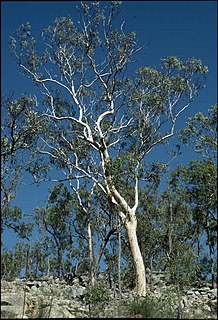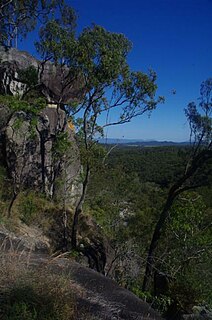
Corymbia abergiana, commonly known as range bloodwood or Rockingham Bay bloodwood, is a species of tree that is endemic to Queensland. It has rough bark on the trunk and larger branches, smooth bark on the smaller branches, lance-shaped adult leaves, flower buds in groups of seven, creamy white flowers and barrel-shaped fruit with a very thick rim.

Eucalyptus kartzoffiana, commonly known as the Araluen gum, is a species of medium-sized tree that is endemic to a small area of southeastern New South Wales. It has rough, fibrous or flaky bark on part or most of its trunk, lance-shaped or curved adult leaves, flower buds in groups of three, white flowers and sessile, bell-shaped fruit.

Eucalyptus langleyi, commonly known as the green mallee ash or albatross mallee, is a species of mallee that is endemic to a small area of New South Wales. It has mostly smooth grey to yellowish bark, lance-shaped to curved adult leaves, flower buds in groups of seven, white flowers and cup-shaped to barrel-shaped fruit.

Eucalyptus magnificata, commonly known as blue box or northern blue box, is a species of small tree or sometimes a mallee that is restricted to a small area of New South Wales. It has rough, fibrous or flaky bark on the trunk and larger branches, smooth bark above, broadly lance-shaped to egg-shaped leaves, flower buds in groups of seven, white or pale yellow flowers and conical fruit.

Eucalyptus pachycalyx, commonly known as the shiny-barked gum, is a species of tree that is endemic to north-eastern Australia. It has smooth, pale grey, mottled bark, lance-shaped or curved adult leaves, white flowers and cup-shaped or hemispherical fruit.

Corymbia erythrophloia, commonly known as the red bloodwood, variable-barked bloodwood, red-barked bloodwood or gum-topped bloodwood, is a species of tree that is endemic to Queensland. It has rough bark on the trunk and branches, egg-shaped or lance-shaped adult leaves, flower buds in groups of seven, creamy white flowers and urn-shaped to spherical fruit.
Corymbia clandestina, commonly known as the Drummond Range bloodwood, is a species of small tree that is endemic to Queensland. It has rough, tessellated bark on the trunk and branches, lance-shaped adult leaves, flower buds in groups of seven, white flowers and urn-shaped to barrel-shaped fruit.
Corymbia leptoloma, commonly known as the yellowjacket or Paluma Range yellowjacket, is a species of tree that is endemic to Queensland. It has rough, tessellated bark on the trunk and branches, lance-shaped or curved adult leaves, flower buds in groups of seven and barrel-shaped, urn-shaped or shortened spherical fruit.
Eucalyptus atrata, commonly known as the Herberton ironbark or blue-leaved ironbark, is a small tree that is endemic to Queensland. It has hard, black "ironbark" on the trunk and all but the thinnest branches, lance-shaped adult leaves, buds usually arranged in groups of seven, white flowers and cup-shaped to hemispherical fruit. It is characterised by the blue-grey, powdery bloom on its leaves and flower buds.

Eucalyptus beaniana , commonly known as the Bean's ironbark, is a small tree that is endemic to Queensland. It has rough, furrowed "ironbark" on the trunk and branches, dull green to bluish, lance-shaped to curved adult leaves, flower buds in groups of seven, white flowers and cup-shaped to conical fruit. It is only known from four locations in southern inland Queensland.
Eucalyptus corynodes is a species of tree that is endemic to Queensland. It has hard, dark grey "ironbark", lance-shaped to curved adult leaves, flower buds usually on a branching inflorescence, the buds in groups of seven, white flowers and barrel-shaped to cup-shaped fruit.

Eucalyptus granitica, commonly known as the granite ironbark, is a species of tree that is endemic to Queensland. It has dark grey or black "ironbark" on the trunk and branches, glossy green, lance-shaped to curved adult leaves, flower buds in groups of seven, white flowers and cup-shaped to barrel-shaped fruit.
Eucalyptus kabiana, commonly known as Mt Beerwah mallee, is a species of mallee, rarely a small tree, that is endemic to Queensland. It has smooth white to grey bark, sometimes with a short stocking of rough, fibrous bark at the base. The adult leaves are lance-shaped or curved, the flower buds are arranged in groups of between seven and eleven, the flowers are white and the fruit is hemispherical with protruding valves.

Eucalyptus quadricostata, commonly known as the square-fruited ironbark, is a species of small to medium-sized ironbark that is endemic to Queensland. It has rough ironbark on the trunk and branches, lance-shaped to curved adult leaves, flower buds in groups of seven, white flowers and cup-shaped fruit that are square in cross-section.
Eucalyptus sicilifolia is a species of small ironbark tree that is endemic to Queensland. It has dark ironbark on the trunk and branches, narrow lance-shaped to curved adult leaves, flower buds in groups of seven, white flowers and cup-shaped to barrel-shaped fruit.
Eucalyptus suffulgens is a small to medium-sized tree that is endemic to Queensland. It has hard ironbark on the trunk and larger branches, smooth bark above, lance-shaped adult leaves, flower buds in groups of seven on the ends of branchlets, white flowers and barrel-shaped fruit.
Eucalyptus tardecidens is a species of mallee or small tree that is endemic to north Queensland. It has rough, fibrous or flaky bark on the trunk and branches, lance-shaped adult leaves, flower buds in groups of seven, white flowers and shortened oval to cylindrical fruit.
Eucalyptus lockyeri, commonly known as Lockyer's box, is a species of small tree endemic to a small area in Queensland. It has rough bark near the base of the trunk, smooth bark above, lance-shaped adult leaves, flower buds in groups of seven, white flowers and hemispherical fruit.
Eucalyptus capitanea, commonly known as the desert ridge-fruited mallee, is a species of mallee that is endemic to South Australia. It often has rough, flaky bark on the lower part of the trunk, smooth bark above, lance-shaped adult leaves, ribbed, oval flower buds in groups of seven, cream-coloured flowers and ribbed, urn-shaped fruit.
Eucalyptus farinosa is a species of small tree that is endemic to Queensland. It has hard, dark grey ironbark, egg-shaped to lance-shaped adult leaves, flower buds in groups of seven, white flowers and cup-shaped to barrel-shaped and ribbed fruit.









